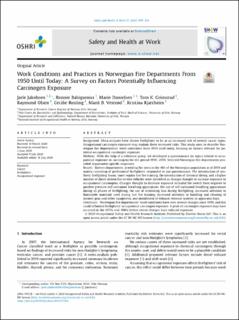| dc.description.abstract | Background Meta-analyses have shown firefighters to be at an increased risk of several cancer types. Occupational carcinogen exposure may explain these increased risks. This study aims to describe Norwegian fire departments' work conditions from 1950 until today, focusing on factors relevant for potential occupational carcinogen exposure. Methods With the help of a reference group, we developed a questionnaire on topics related to occupational exposure to carcinogens for the period 1950–2018. Selected Norwegian fire departments provided department-specific responses. Results Sixteen departments, providing fire services for 48% of the Norwegian population as of 2019 and mainly consisting of professional firefighters, responded to our questionnaire. The introduction of synthetic firefighting foams, more regular live fire training, the introduction of chemical diving, and a higher number of diesel-driven fire service vehicles were identified as changes thought to increase exposure to occupational carcinogens. Changes thought to decrease exposure included the switch from negative to positive pressure self-contained breathing apparatuses, the use of self-contained breathing apparatuses during all phases of firefighting, the use of ventilating fans during firefighting, increased attention to flammable materials used during live fire training, increased attention to handling and cleaning of turnout gear and other equipment, and installment of exhaust removal systems in apparatus bays. Conclusion Norwegian fire departments' work conditions have seen several changes since 1950, and this could influence firefighters' occupational carcinogen exposure. A peak of carcinogen exposure may have occurred in the 1970s and 1980s before recent changes have reduced exposure. | |
